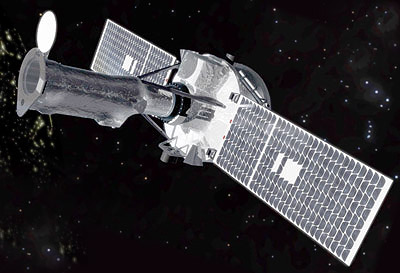Thank you very much for visiting Gunter's Space Page. I hope that this site is useful and informative for you.
If you appreciate the information provided on this site, please consider supporting my work by making a simple and secure donation via PayPal. Please help to run the website and keep everything free of charge. Thank you very much.
IRIS (SMEX 12, Explorer 94)

IRIS (SMEX 12) [NASA]
IRIS (Interface Region Imaging Spectrograph) is a small solar observatory.
The IRIS mission will use a solar telescope and spectrograph to explore the solar chromospheres. This is a crucial region for understanding energy transport into the solar wind and an archetype for stellar atmospheres. Recent discoveries have shown the chromosphere is significantly more dynamic and structured than previously thought. The unique instrument capabilities, coupled with state of the art 3-D modeling, will explore this dynamic region in detail. The mission will greatly extend the scientific output of existing heliophysics spacecraft that follow the effects of energy release processes from the sun to Earth.
The IRIS instrument is a multi-channel imaging spectrograph with a 20 cm UV telescope. IRIS will obtain spectra along a slit (1/3 arcsec wide), and slit-jaw images. The CCD detectors will have 1/6 arcsec pixels. IRIS will have an effective spatial resolution between 0.33 and 0.4 arcsec and a maximum field of view of 120 arcsec.
The far-UV channel covers: 1332-1358 Å and 1390-1406 Å with 40 mÅ resolution and an effective area of 2.8 cm2.
The near-UV channel covers: 2785-2835 Å with 80 mÅ resolution and an effective area 0.3 cm2.
Slit-jaw imaging will have four passbands:
- 1335 Å and 1400 Å with 40 Å bandpass each
- 2796 Å and 2831 Å with 4 Å bandpass each
IRIS will have a high data rate (0.7 Mbit/s on average) so that the baseline cadence is: 5 s for slit-jaw images, 1 s for 6 spectral windows, including rapid rastering to map solar regions.
| Nation: | USA |
|---|---|
| Type / Application: | Particle imaging |
| Operator: | NASA |
| Contractors: | Lockheed Martin Space Systems Advanced Technology Center (ATC) |
| Equipment: | 20 cm UV telescope with multi-channel imaging spectrograph |
| Configuration: | |
| Propulsion: | ? |
| Power: | 2 deployable fixed solar arrays, batteries |
| Lifetime: | 2 years |
| Mass: | 236 kg |
| Orbit: | 596 km × 666 km, 97.9° |
| Satellite | COSPAR | Date | LS | Launch Vehicle | Remarks | |
|---|---|---|---|---|---|---|
| IRIS (SMEX 12, Explorer 94) | 2013-033A | 28.06.2013 | Va, L-1011, RW30/12 | Pegasus-XL |
References:
- Lockheed Martin Solar and Astrophysics Lab: IRIS website
- SAMPEX (SMEX 1)
- FAST (SMEX 2)
- SWAS (SMEX 3)
TOMS (SMEX)- cancelled- TRACE (SMEX 4)
- WIRE (SMEX 5)
- HESSI (RHESSI, SMEX 6)
- GALEX (SMEX 7)
- SPIDR (SMEX 8) - cancelled
- AIM (SMEX 9)
- IBEX (SMEX 10)
- NuSTAR (SMEX 11)
- IRIS (SMEX 12)
- GEMS (SMEX 13) - cancelled
- IXPE (SMEX 14)
- PUNCH-NFI, PUNCH-WFI 1, 2, 3 (SMEX 15)
- TRACERS A, B (SMEX 16)
- COSI (SMEX 17)
- Explorer Program
